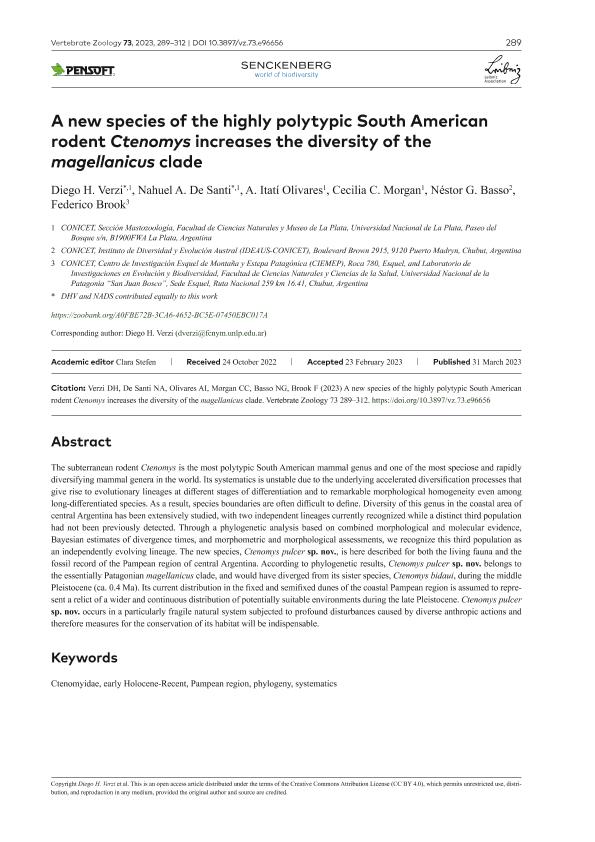Mostrar el registro sencillo del ítem
dc.contributor.author
Verzi, Diego Hector

dc.contributor.author
de Santi, Nahuel Antu

dc.contributor.author
Olivares, Adriana Itati

dc.contributor.author
Morgan, Cecilia Clara

dc.contributor.author
Basso, Nestor Guillermo

dc.contributor.author
Brook, Federico

dc.date.available
2024-01-11T12:24:04Z
dc.date.issued
2023-03
dc.identifier.citation
Verzi, Diego Hector; de Santi, Nahuel Antu; Olivares, Adriana Itati; Morgan, Cecilia Clara; Basso, Nestor Guillermo; et al.; A new species of the highly polytypic South American rodent Ctenomys increases the diversity of the magellanicus clade; Senckenbergische Naturforschende Gesellschaft; Vertebrate Zoology; 73; 3-2023; 289-312
dc.identifier.issn
1864-5755
dc.identifier.uri
http://hdl.handle.net/11336/223308
dc.description.abstract
The subterranean rodent Ctenomys is the most polytypic South American mammal genus and one of the most speciose and rapidly diversifying mammal genera in the world. Its systematics is unstable due to the underlying accelerated diversification processes that give rise to evolutionary lineages at different stages of differentiation and to remarkable morphological homogeneity even among long-differentiated species. As a result, species boundaries are often difficult to define. Diversity of this genus in the coastal area of central Argentina has been extensively studied, with two independent lineages currently recognized while a distinct third population had not been previously detected. Through a phylogenetic analysis based on combined morphological and molecular evidence, Bayesian estimates of divergence times, and morphometric and morphological assessments, we recognize this third population as an independently evolving lineage. The new species, Ctenomys pulcer sp. nov., is here described for both the living fauna and the fossil record of the Pampean region of central Argentina. According to phylogenetic results, Ctenomys pulcer sp. nov. belongs to the essentially Patagonian magellanicus clade, and would have diverged from its sister species, Ctenomys bidaui, during the middle Pleistocene (ca. 0.4 Ma). Its current distribution in the fixed and semifixed dunes of the coastal Pampean region is assumed to represent a relict of a wider and continuous distribution of potentially suitable environments during the late Pleistocene. Ctenomys pulcer sp. nov. occurs in a particularly fragile natural system subjected to profound disturbances caused by diverse anthropic actions and therefore measures for the conservation of its habitat will be indispensable.
dc.format
application/pdf
dc.language.iso
eng
dc.publisher
Senckenbergische Naturforschende Gesellschaft
dc.rights
info:eu-repo/semantics/openAccess
dc.rights.uri
https://creativecommons.org/licenses/by-nc-sa/2.5/ar/
dc.subject
CTENOMYIDAE
dc.subject
EARLY HOLOCENE-RECENT
dc.subject
PAMPEAN REGION
dc.subject
PHYLOGENY
dc.subject
SYSTEMATICS
dc.subject.classification
Zoología, Ornitología, Entomología, Etología

dc.subject.classification
Ciencias Biológicas

dc.subject.classification
CIENCIAS NATURALES Y EXACTAS

dc.title
A new species of the highly polytypic South American rodent Ctenomys increases the diversity of the magellanicus clade
dc.type
info:eu-repo/semantics/article
dc.type
info:ar-repo/semantics/artículo
dc.type
info:eu-repo/semantics/publishedVersion
dc.date.updated
2024-01-09T15:05:23Z
dc.identifier.eissn
2625-8498
dc.journal.volume
73
dc.journal.pagination
289-312
dc.journal.pais
Bulgaria

dc.journal.ciudad
Sofia
dc.description.fil
Fil: Verzi, Diego Hector. Universidad Nacional de La Plata. Facultad de Ciencias Naturales y Museo; Argentina. Consejo Nacional de Investigaciones Científicas y Técnicas. Centro Científico Tecnológico Conicet - La Plata; Argentina
dc.description.fil
Fil: de Santi, Nahuel Antu. Universidad Nacional de La Plata. Facultad de Ciencias Naturales y Museo; Argentina. Consejo Nacional de Investigaciones Científicas y Técnicas. Centro Científico Tecnológico Conicet - La Plata; Argentina
dc.description.fil
Fil: Olivares, Adriana Itati. Universidad Nacional de La Plata. Facultad de Ciencias Naturales y Museo; Argentina. Consejo Nacional de Investigaciones Científicas y Técnicas. Centro Científico Tecnológico Conicet - La Plata; Argentina
dc.description.fil
Fil: Morgan, Cecilia Clara. Universidad Nacional de La Plata. Facultad de Ciencias Naturales y Museo; Argentina. Consejo Nacional de Investigaciones Científicas y Técnicas. Centro Científico Tecnológico Conicet - La Plata; Argentina
dc.description.fil
Fil: Basso, Nestor Guillermo. Universidad Nacional de La Plata. Facultad de Ciencias Naturales y Museo; Argentina. Consejo Nacional de Investigaciones Científicas y Técnicas. Centro Científico Tecnológico Conicet - La Plata; Argentina
dc.description.fil
Fil: Brook, Federico. Universidad Nacional de La Plata. Facultad de Ciencias Naturales y Museo; Argentina. Consejo Nacional de Investigaciones Científicas y Técnicas. Centro Científico Tecnológico Conicet - La Plata; Argentina
dc.journal.title
Vertebrate Zoology
dc.relation.alternativeid
info:eu-repo/semantics/altIdentifier/url/https://vertebrate-zoology.arphahub.com/article/96656/
dc.relation.alternativeid
info:eu-repo/semantics/altIdentifier/doi/http://dx.doi.org/10.3897/vz.73.e96656
Archivos asociados
